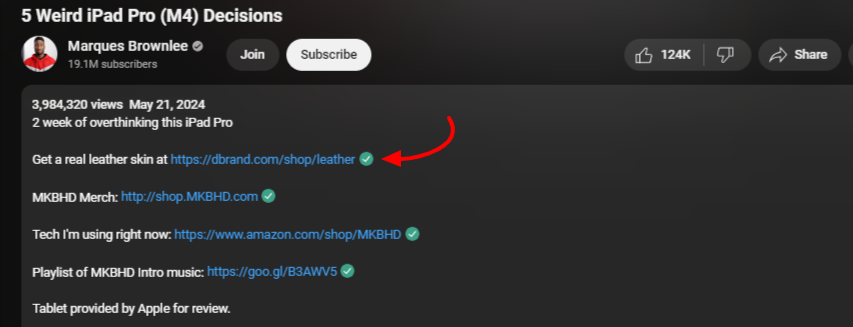Contents
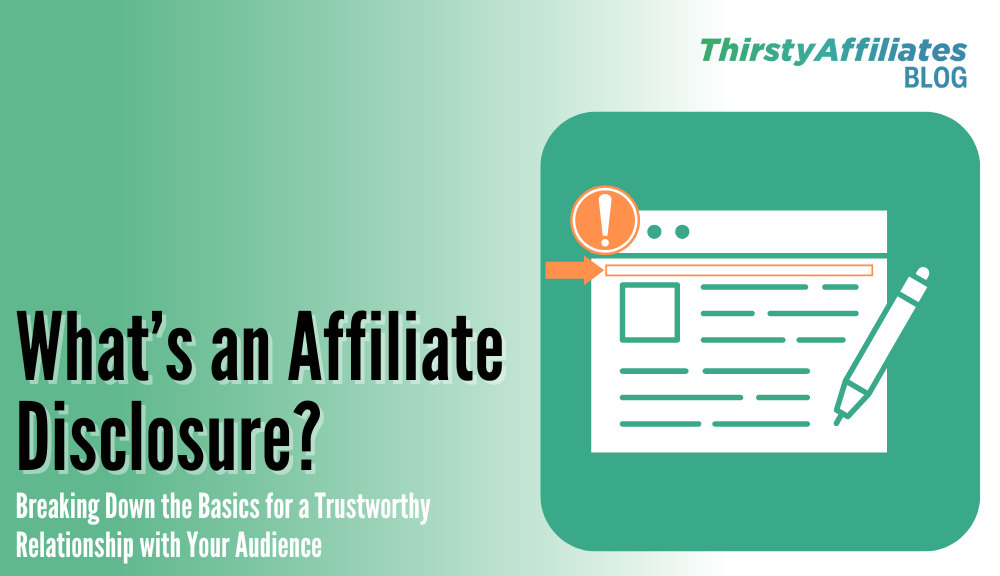
You’ve just landed the perfect affiliate partnership, and your content is ready to bring in commissions. But there’s one crucial element you can’t overlook: the affiliate disclosure.
It’s more than a formality; it’s a key piece of transparency that can build trust with your audience and keep you compliant with regulations.
But what exactly is an affiliate disclosure, and why is it so important?
Affiliate disclosures might seem like small details, but they play a significant role in the affiliate marketing world. Understanding the ins and outs of these disclosures can make a huge difference in your credibility and success.
In this article, we’ll cover everything you need to know about affiliate disclosures. We’ll explain why they’re an essential part of affiliate promotions, what the regulations say, and how you can craft clear, effective disclosures that keep you on the right side of the law and in the good graces of your audience.
What is an Affiliate Disclosure?
An affiliate disclosure is a statement that informs your audience about your affiliate relationships.
When you include affiliate links in your content, you must let your readers know that you may earn a commission if they make a purchase through these links. This transparency is crucial for building trust with your audience and staying compliant with legal regulations.
Affiliate link disclosures can take various forms. They can be a short statement at the beginning or end of a blog post, a dedicated page on your website, or a simple note included next to each affiliate link.
Whether you’re aiming to boost your transparency, protect yourself legally, or simply enhance your readers’ trust, understanding affiliate disclosures is a must for any successful affiliate marketer.
Why Is It Important to Have One?
Having an affiliate disclosure is important for several reasons:
1. Legal Compliance: Regulatory bodies like the Federal Trade Commission (FTC) in the United States require affiliates to disclose their relationships with merchants. Failing to do so can lead to legal consequences, including fines and penalties. The FTC guidelines are designed to ensure that consumers are not misled and can make informed purchasing decisions.
2. Building Trust with Your Audience: Transparency is key to building and maintaining trust with your audience. When you disclose your affiliate relationships, you show your audience that you’re honest and trustworthy. This can lead to increased loyalty and long-term engagement. Readers are more likely to trust your recommendations if they know you are upfront about earning a commission.
3. Enhancing Credibility: An affiliate link disclosure enhances your credibility as a content creator. It shows that you are committed to ethical marketing practices and that you value honesty. Credibility is crucial in the digital age where consumers are becoming increasingly skeptical of online recommendations. By being transparent, you demonstrate your integrity and professionalism.
4. Avoiding Penalties and Loss of Affiliate Programs: In accordance with the law, most all affiliate programs require you to disclose your affiliate links as part of their terms of service. Failing to comply with these requirements can result in being removed from the affiliate program, losing your commissions, and facing other penalties.
Including an affiliate link disclosure in your marketing strategy is essential. It guarantees you meet legal standards, fosters trust and credibility with your audience, and supports ethical marketing practices.
Who Needs an Affiliate Disclosure?
Anyone who uses affiliate links in their content needs to include affiliate disclosures. This includes:
- Bloggers and Content Creators: If you run a blog or create content that features affiliate links, you must disclose your affiliate relationships.
- Social Media Influencers: Influencers who share affiliate links on social platforms like Instagram, YouTube, Twitter, or TikTok must disclose partnership links. This includes adding disclaimers in video descriptions, posts, or even within the content itself.
- Website Owners: Sites using affiliate marketing, including niche sites, review sites, and eCommerce sites, must have an affiliate link disclosure.
- Email Marketers: If you send out newsletters or marketing emails that include affiliate links, you must disclose these affiliations within the email content.
- Podcasters and Video Creators: Content creators who use affiliate links in their podcasts or video descriptions also need to disclose these links. This can be done by including written disclosures in the show notes or video descriptions or verbally called out in the recording.
Simply put, anyone who wishes to monetize their content with affiliate links must include an affiliate disclosure alongside their promotions.
How to Properly Disclose for Affiliate Links
Implementing proper disclosures can be tricky, especially with the varying requirements across different platforms.
To help you navigate this essential aspect of affiliate marketing, we’ve compiled a few general best practices and specific tips for different platforms.
Whether you’re blogging, posting on social media, or creating video content, these guidelines will ensure you disclose affiliate links effectively and compliantly.
Best Practices on How to Properly Disclose for Affiliate Links
1. Be Clear and Conspicuous: Your affiliate disclosure should be easily noticeable. Place it where readers will see it without having to search for it. Avoid burying the disclosure in a lengthy paragraph or at the bottom of a post.
2. Use Simple Language: Keep your disclosure straightforward and easy to understand. Avoid jargon or legalese. Your audience should immediately grasp that you may earn a commission if they make a purchase through your links.
3. Consistency is Key: Make sure to include your affiliate disclosure every time you share an affiliate link. Consistency reinforces transparency and trust.
4. Align with Your Brand: Tailor your disclosure to fit your brand’s voice and style. Whether your tone is casual, professional, or humorous, ensure your disclosure feels like a natural part of your content.
5. Follow Legal Guidelines: Different countries have specific regulations regarding affiliate disclosures. Familiarize yourself with the guidelines in your jurisdiction, such as the FTC guidelines in the United States, and ensure your disclosures meet these requirements.
Affiliate Disclosure Tips for Different Platforms
Blog Posts
- Pre-Post Disclosure: Start your blog post with a brief disclosure statement. For example, “Before we dive into this article, please note that some links in this post are affiliate links. If you purchase through these links, I may earn a commission at no extra cost to you. Thank you for supporting my blog!”
- In-Content Disclosure: Include the disclosure within the content itself, especially near the affiliate links. This ensures readers are aware of the affiliate relationship the moment they encounter the link. For example, “Check out this great product (affiliate link). If you decide to buy, I may earn a small commission.”
- Post-Script Disclosure: End your blog post with a disclosure note to remind readers. For example, “P.S. This post contains affiliate links. If you make a purchase through these links, I earn a small commission. Thanks for your support!”
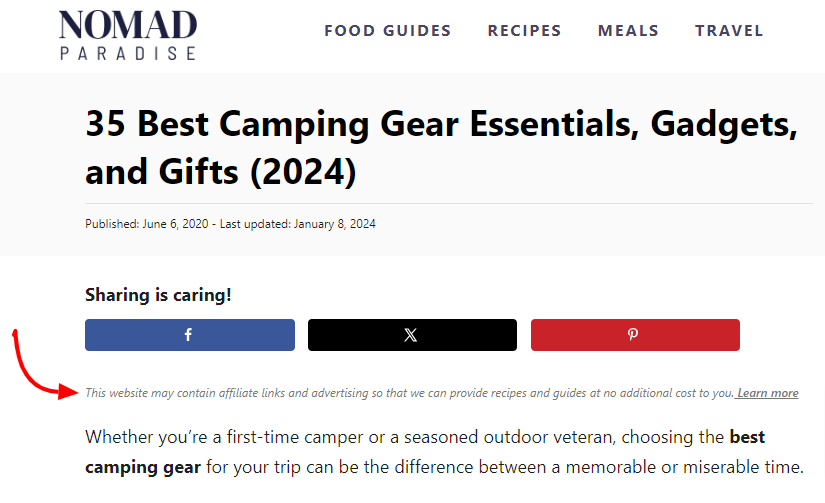
💡Learn More on Why Should You Monetize Your Blog with Affiliate Marketing
Social Media
- Hashtags: Use clear hashtags like #ad, #affiliate, or #sponsored to disclose affiliate links on platforms like Facebook, Instagram, and X. For example, “Loving my new workout gear! #ad #affiliate”
- In-Caption Disclosure: Include a brief disclosure within the caption of your post. For example, “I may earn a commission if you purchase through these links. Thanks for supporting my content!”
- Bio Disclosure: Place a permanent disclosure in your social media bio. For example, “Affiliate links included. I earn a commission on purchases at no extra cost to you.”

💡Learn More on How to Promote Affiliate Links on Social Media
Podcasts and Video Content
- Verbal Disclosure: Clearly state your disclosure at the beginning or end of your video. For example, “Just so you know, this episode contains affiliate links. If you purchase through these links, I may earn a commission at no extra cost to you.”
- Description Box Disclosure: Include a written disclosure in the video description box. For example, “This video includes affiliate links. If you purchase through these links, I earn a small commission. Thanks for your support!”
- On-Screen Disclosure: Display a brief disclosure on-screen during the video, especially when showing the affiliate link. For example, “Affiliate link: I may earn a commission if you buy through this link.”
💡Learn More on How to Do Affiliate Marketing for Podcasts
💡Learn More on How to Promote Affiliate Links on YouTube
Email Newsletters
- Email Signature: Add a disclosure statement to your email signature. For example, “Note: This email contains affiliate links. I earn a small commission if you make a purchase, at no extra cost to you.”
- In-Email Disclosure: Include a brief disclosure at the beginning or end of your email content. For example, “Some links in this email are affiliate links. If you click through and make a purchase, I may earn a commission. Thanks for your support!”

💡Learn More on How to Increase Affiliate Sales with Email Marketing
Let ThirstyAffialites Handle Affiliate Link Disclosures on Your Website
We imagine you’re busy creating amazing content, and the last thing you want to worry about is making sure all your affiliate disclosures are in place.
This is where ThirstyAffiliates steps in to simplify your life and keep your site compliant with FTC guidelines.
Automatic Disclosure Placement
With ThirstyAffiliates, you don’t have to manually add disclosure statements to every post or page. It automates this process, ensuring a disclosure notice appears at the bottom of each piece of content.

Additionally, disclosures can be automatically included in product displays, making sure your affiliate links are always transparent.tip
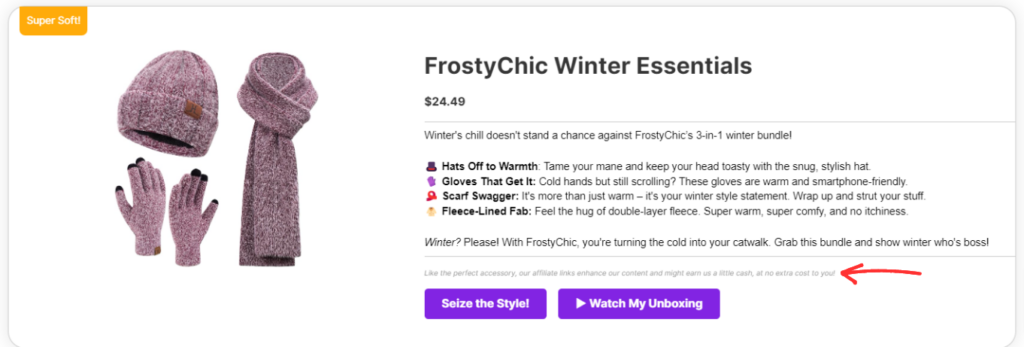
These automation features save you time and guarantee consistency across your site, so you can focus on what you do best – creating valuable content for your audience.
Customizable Tooltips
Let’s say you’re writing a blog post about your favorite tech gadgets, and you include several affiliate links. ThirstyAffiliates allows you to enable an icon next to these links that displays a disclosure message when hovered over.
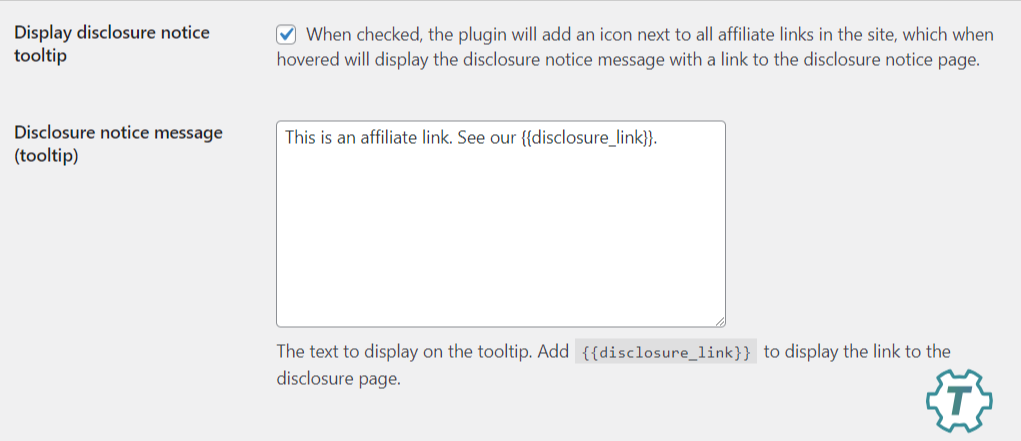
This not only keeps you compliant but also integrates seamlessly into your content without disrupting the flow for your readers.
Personalized Disclosure Messages
You have a unique brand voice, and your disclosures should reflect that. ThirstyAffiliates lets you customize the text of your disclosure messages.
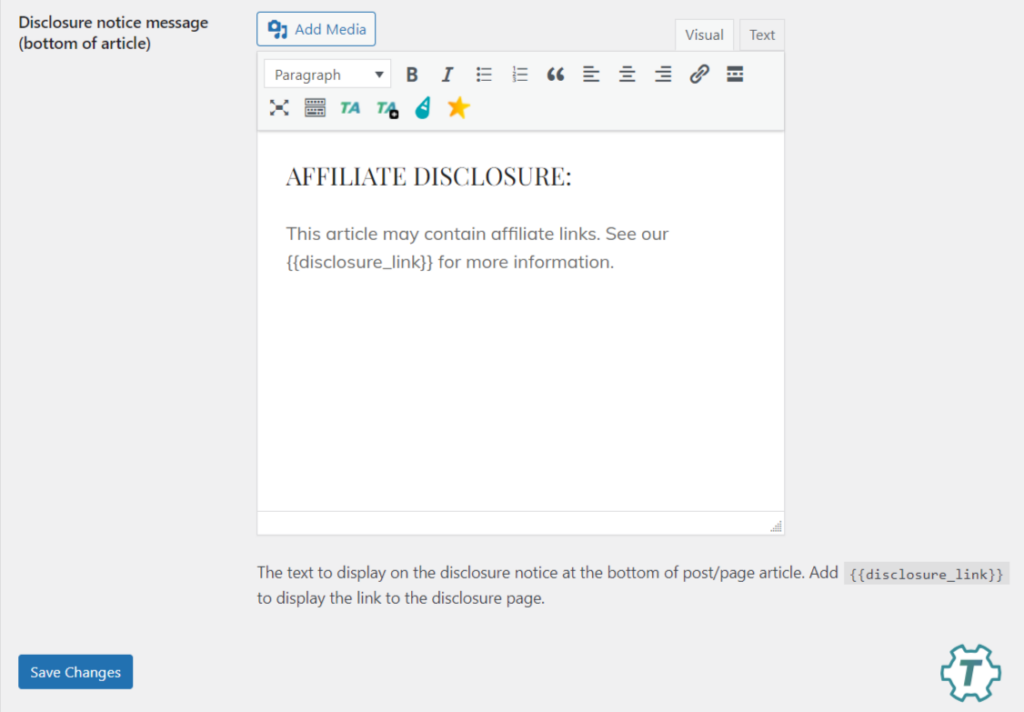
Whether you prefer a friendly, casual tone or a more formal approach, you can tailor the messages to align perfectly with your brand.
Link Text Customization
If you have a dedicated disclosure page, you can customize the link text that directs your readers there.

This makes it clear and accessible, providing all the information they need about your affiliate relationships in a straightforward manner.
Conclusion
Disclosing affiliate links doesn’t have to be a chore. By following best practices like being clear, consistent, and brand-aligned, you build a stronger bond with your audience.
ThirstyAffiliates simplifies this with automated and customizable disclosures, ensuring you stay compliant effortlessly. This allows you to focus on creating great content while keeping your audience informed and engaged.
With ThirstyAffiliates, transparency becomes a seamless part of your strategy, letting you do what you love without worrying about the legal details.
If you liked this post, be sure to follow us on Twitter, Instagram, Facebook, Pinterest, and LinkedIn! And don’t forget to subscribe in the box below.

